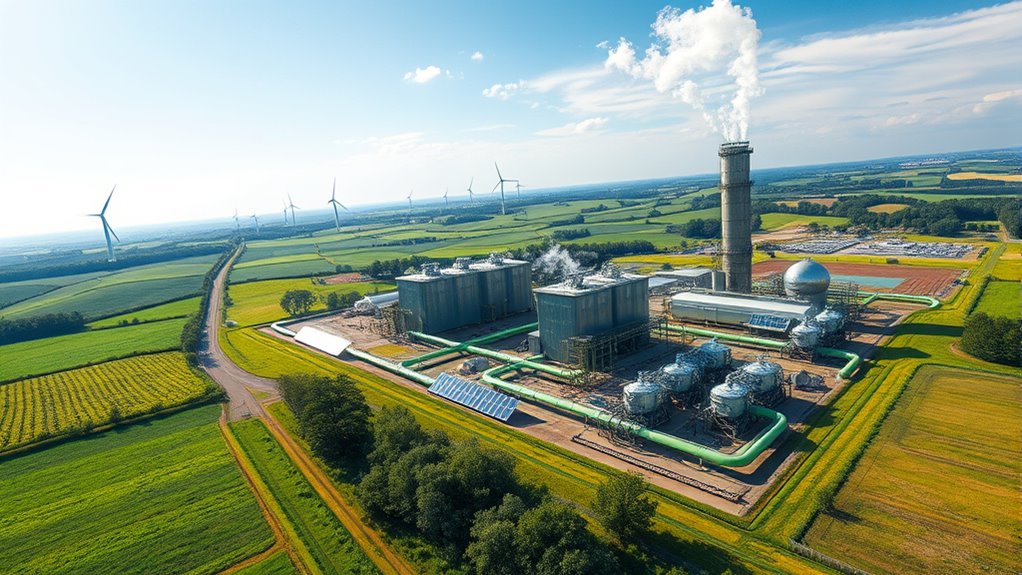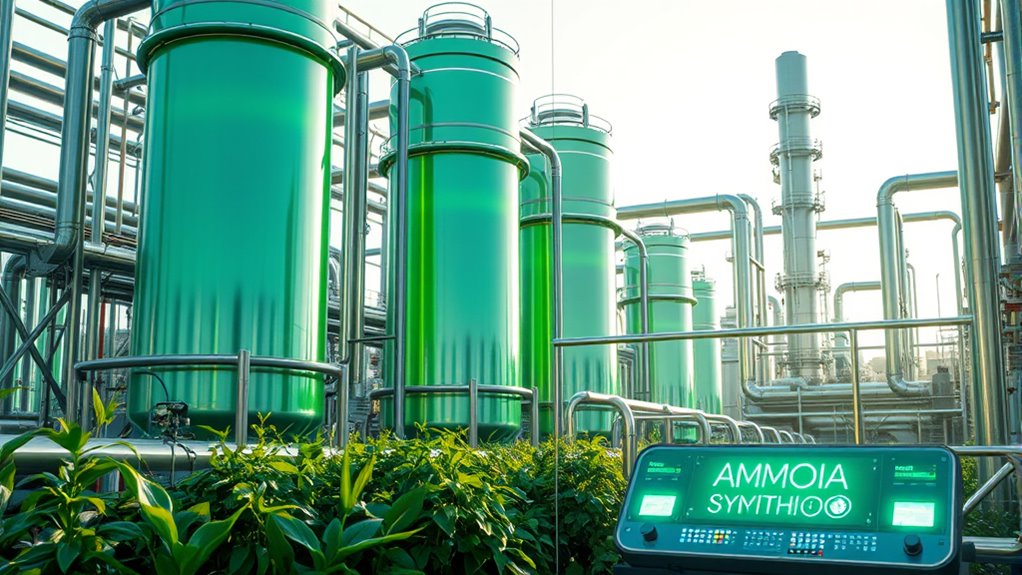Green ammonia is transforming fertilizer production by using renewable energy sources like wind or solar to produce hydrogen through electrolysis. This process avoids the heavy greenhouse gas emissions linked to traditional methods that rely on fossil fuels. By adopting green ammonia, you can reduce environmental impacts, support a more stable supply chain, and promote local energy storage. If you’re interested, there’s more to discover about how this sustainable alternative is shaping the future of agriculture and energy.
Key Takeaways
- Green ammonia is produced using renewable energy and water electrolysis, eliminating CO2 emissions associated with traditional methods.
- Decarbonizing fertilizer production through green ammonia reduces the industry’s carbon footprint significantly.
- Advances in renewable energy lower costs and enhance the economic viability of green ammonia for fertilizer use.
- Localized green ammonia production and storage improve supply chain stability and reduce transportation emissions.
- Policy support and incentives are accelerating the adoption of sustainable ammonia solutions in agriculture.

Have you ever wondered how we can produce ammonia without harming the environment? Traditional methods rely heavily on fossil fuels, primarily natural gas, which not only depletes finite resources but also releases significant amounts of greenhouse gases. This process, known as Steam Methane Reforming, contributes heavily to the carbon footprint of fertilizer production.
Traditional ammonia production relies on fossil fuels, depleting resources and emitting greenhouse gases.
However, with the rise of renewable energy, there’s a promising shift happening in how we create ammonia. By harnessing wind, solar, or hydropower, we can generate the electricity needed for electrolysis—splitting water into hydrogen and oxygen—without emitting carbon dioxide. This approach transforms ammonia production from a carbon-intensive process into a sustainable one, drastically reducing the environmental impact.
Using renewable energy to produce green ammonia doesn’t just benefit the planet; it also offers economic advantages. As renewable sources become more affordable and widespread, the costs associated with producing green ammonia are decreasing. This shift can lead to a more stable and predictable supply chain, less vulnerable to fluctuations in fossil fuel prices.
Plus, it aligns with global efforts to decarbonize industries and meet climate targets. Essentially, adopting renewable energy for ammonia synthesis helps you minimize your carbon footprint, making the entire supply chain more sustainable and responsible.
Green ammonia also opens new opportunities for energy storage and transportation. Unlike conventional ammonia, which is often produced at large, centralized facilities, green ammonia can be generated locally using renewable resources available in specific regions. This decentralization reduces the need for long-distance transportation, which is both costly and carbon-intensive.
You can think of green ammonia as a potential energy carrier—storing excess renewable energy for later use or transportation to areas lacking abundant renewable resources. This flexibility makes it a versatile solution for reducing emissions across the entire energy and agricultural sectors.
Furthermore, as governments and industries push for cleaner practices, policies and incentives are increasingly favoring renewable-based solutions. This encourages companies and farmers alike to adopt greener alternatives, aligning economic interests with environmental stewardship.
Frequently Asked Questions
What Are the Main Challenges in Scaling Green Ammonia Production?
You face several challenges in scaling green ammonia production. Technological innovations are essential to improve efficiency and reduce costs, but they’re still evolving.
Supply chain logistics also pose hurdles, as transporting and storing green ammonia requires specialized infrastructure.
You need to address these issues simultaneously to make green ammonia viable at a commercial scale.
Overcoming these obstacles will be key to enabling widespread adoption and decarbonizing fertilizer production.
How Does Green Ammonia Compare Cost-Wise to Traditional Ammonia?
At first glance, green ammonia might seem a bit more costly, but the real story involves a nuanced cost comparison. While traditional ammonia benefits from established infrastructure, green ammonia’s economic viability is improving thanks to declining renewable energy costs and technological advancements.
Over time, these factors could tip the scales, making green ammonia not just environmentally friendly but also a smart investment. The future of cost is evolving, and green ammonia’s potential shines through.
What Policies Support Green Ammonia Adoption Globally?
You can benefit from policies that support green ammonia adoption through various incentives. Policy incentives like subsidies, tax credits, and grants encourage producers to develop green ammonia projects.
International agreements, such as climate accords, also push governments to prioritize clean energy solutions. By leveraging these policies, you’ll find it easier to invest in green ammonia, reduce emissions, and align with global sustainability goals.
Ultimately, these policies make green ammonia more accessible and economically viable.
Are There Safety Concerns With Green Ammonia Handling?
Handling safety is a key concern when working with ammonia, whether green or traditional. You need to be cautious with ammonia storage, as leaks can pose health risks. Proper safety measures, such as using sealed containers and adequate ventilation, are vital.
Regular training and strict protocols help guarantee safe handling, minimizing the risk of accidents. Green ammonia’s safety profile is similar to conventional ammonia, but careful management remains essential.
What Companies Are Leading in Green Ammonia Development?
You’ll find that major players like Yara, OCI, and Siemens Energy are leading in green ammonia development, investing heavily in renewable feedstocks and carbon capture technologies.
Remarkably, the global green ammonia market is projected to grow at a compound annual rate of over 20% by 2030.
These companies are pioneering innovative solutions to produce sustainable fertilizer, reducing reliance on fossil fuels, and advancing the shift to a greener, more decarbonized energy landscape.
Conclusion
As you consider the future of sustainable agriculture, remember that green ammonia could cut global CO2 emissions by up to 1.8 gigatons annually—about the same as the entire UK’s emissions in 2019. This exciting shift not only promises a cleaner planet but also offers a chance for you to be part of innovative solutions shaping a greener world. Embracing green ammonia could be the key to powering a more sustainable, responsible fertilizer industry.









